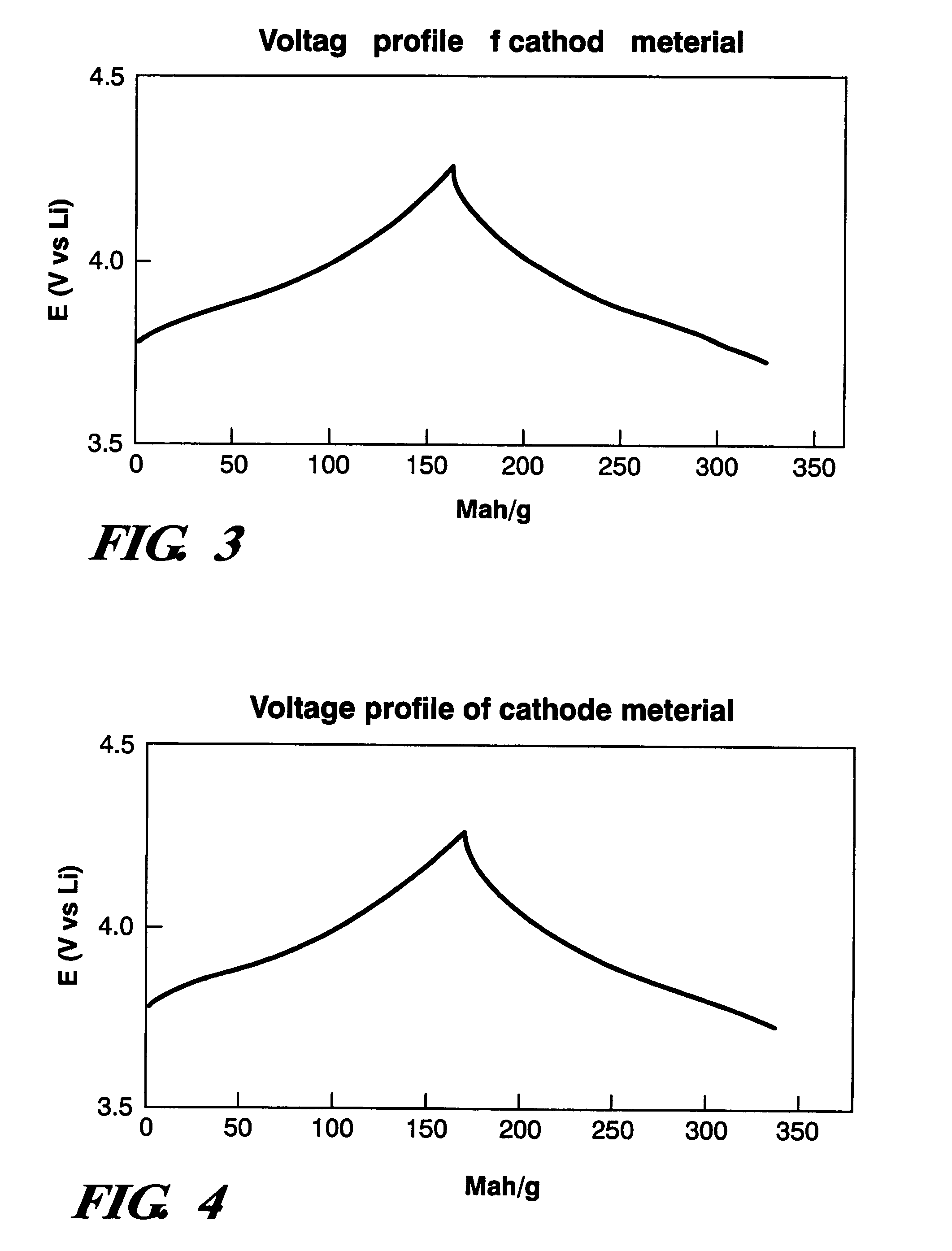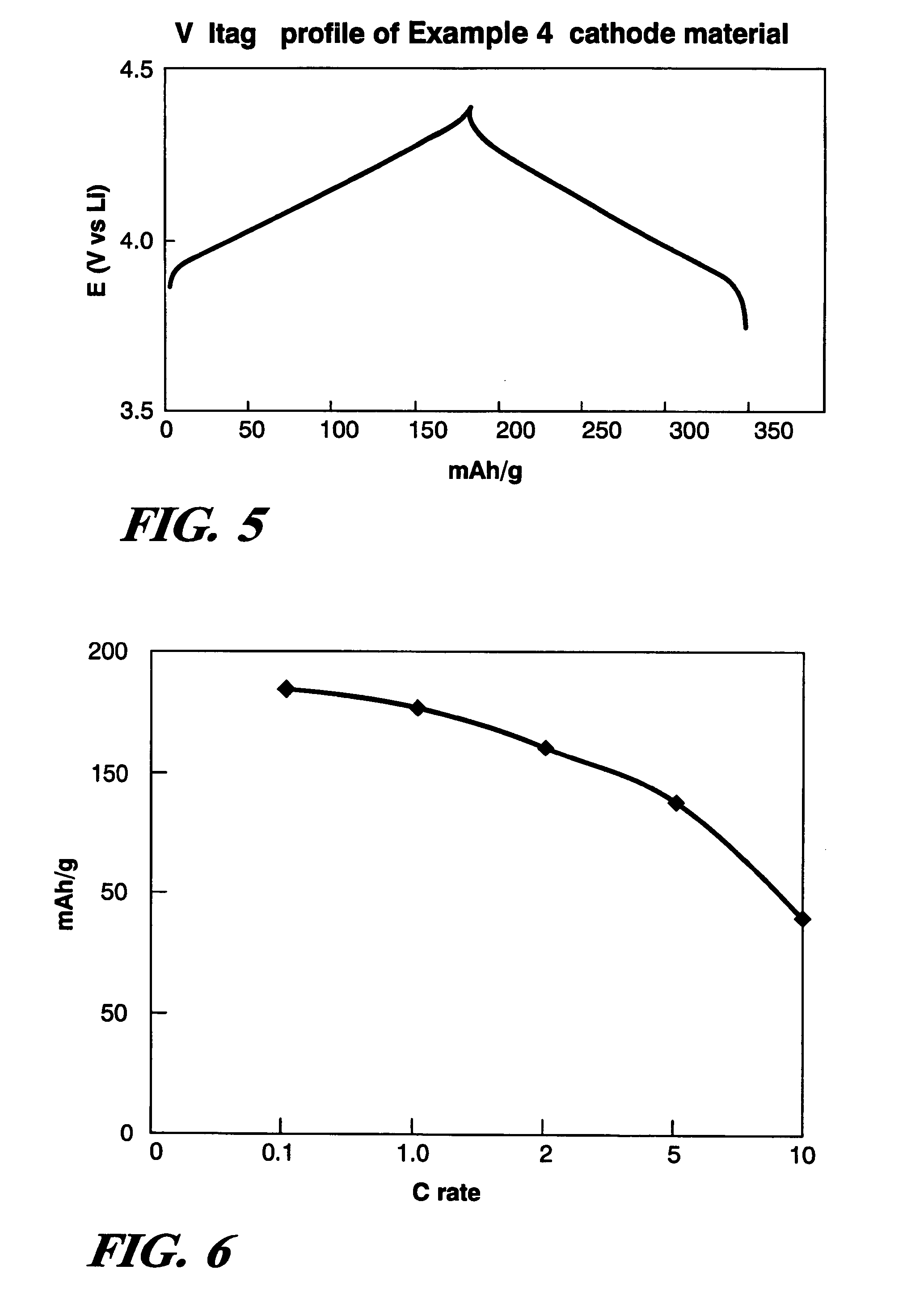Cathode material for lithium battery
- Summary
- Abstract
- Description
- Claims
- Application Information
AI Technical Summary
Benefits of technology
Problems solved by technology
Method used
Image
Examples
example 1
Solution (SLN) 4
Synthesis
[0025]The following amounts of the identified materials were weighed into a reaction vessel without mixing: 17.24 g of LiNO3, 50.89 g of Ni(NO3)2.6H2O, 7.28 g of Co(NO3)2.6H2O, 4.81 g of Mg(NO3)2.6H2O, 4.69 g of Al(NO3)3.9H2O, 1.50 g of TiO2 powder, and 75.0 g of H2O. In this example, 75 ml of water was used in addition to the water inherently contained in the nitrate salts. However, this water was added as a precaution to obtaining a solution of all the ingredients, except the titanium dioxide powder. Usually it is not necessary to add water apart from the water contained in the crystal structure of the hydrated nitrate salts and, preferably, such additional water is not used in the synthesis of the cathode materials because time and thermal energy is expended in its removal.
[0026]The materials in the reactor were heated in a microwave oven until a solution was formed. The microwave oven had a single power setting of 1050 watts and operated at a frequency o...
example 2
SLN9
[0036]The following amounts of the identified materials were weighed into a reaction vessel without mixing: 68.96 g of LiNO3, 203.56 g of Ni(NO3)2.6H2O, 43.65 g of Co(NO3)2.6H2O, 12.82 g of Mg(NO3)2.6H2O, 7.99 g of TiO2, and 45.01 g of H2O. These amounts of the respective constituents were specified to yield a final crystalline oxide product of the composition: Li1.0(Ni0.7Co0.15Ti0.1Mg0.05)O2.
[0037]The synthesis of this Example 2 oxide material was the same as was described with respect to Example 1. As in Example 1 the additional 45 grams of water were used to assure fluidity of the liquid for dispersion of the TiO2, but the additional water was not necessary in view of the ample amount of water provided from the crystalline water present in the nitrate salts. After the liquefaction, desiccation and calcining of the Example 2 material, a quantitative chemical analysis confirmed the indicated desired molar ratio of the metallic elements. An XRD likewise confirmed the layered cry...
example 3
SLN8
[0040]The following amounts of the identified materials were weighed into a reaction vessel without mixing: 68.96 g of LiNO3, 203.56 g of Ni(NO3)2.6H2O, 43.65 g of Co(NO3)2.6H2O, 12.82 g of Mg(NO3)2.6H2O, 18.76 g of Al(NO3)3.9H2O, and 38.64 g of H2O. These amounts of the respective constituents were specified to yield a final crystalline oxide product of the composition: Li1.0(Ni0.7Co0.2Mg0.05Al0.05)O2.
[0041]The synthesis of this Example 3 oxide material was the same as described with respect to Example 1. As in Example 1 the additional water were used to assure fluidity of the liquid but the additional water was not necessary in view of the ample amount of water provided from the crystalline water present in the nitrate salts. After the liquefaction, desiccation and calcining of the Example 3 material, a quantitative chemical analysis confirmed the indicated desired molar ratio of the metallic elements. An XRD likewise confirmed the layered crystalline structure of the R3m Spac...
PUM
 Login to View More
Login to View More Abstract
Description
Claims
Application Information
 Login to View More
Login to View More - R&D
- Intellectual Property
- Life Sciences
- Materials
- Tech Scout
- Unparalleled Data Quality
- Higher Quality Content
- 60% Fewer Hallucinations
Browse by: Latest US Patents, China's latest patents, Technical Efficacy Thesaurus, Application Domain, Technology Topic, Popular Technical Reports.
© 2025 PatSnap. All rights reserved.Legal|Privacy policy|Modern Slavery Act Transparency Statement|Sitemap|About US| Contact US: help@patsnap.com



